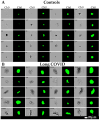Possible Role of Fibrinaloid Microclots in Postural Orthostatic Tachycardia Syndrome (POTS): Focus on Long COVID
- PMID: 38392604
- PMCID: PMC10890060
- DOI: 10.3390/jpm14020170
Possible Role of Fibrinaloid Microclots in Postural Orthostatic Tachycardia Syndrome (POTS): Focus on Long COVID
Abstract
Postural orthostatic tachycardia syndrome (POTS) is a common accompaniment of a variety of chronic, inflammatory diseases, including long COVID, as are small, insoluble, 'fibrinaloid' microclots. We here develop the argument, with accompanying evidence, that fibrinaloid microclots, through their ability to block the flow of blood through microcapillaries and thus cause tissue hypoxia, are not simply correlated with but in fact, by preceding it, may be a chief intermediary cause of POTS, in which tachycardia is simply the body's exaggerated 'physiological' response to hypoxia. Similar reasoning accounts for the symptoms bundled under the term 'fatigue'. Amyloids are known to be membrane disruptors, and when their targets are nerve membranes, this can explain neurotoxicity and hence the autonomic nervous system dysfunction that contributes to POTS. Taken together as a system view, we indicate that fibrinaloid microclots can serve to link POTS and fatigue in long COVID in a manner that is at once both mechanistic and explanatory. This has clear implications for the treatment of such diseases.
Keywords: Long COVID; TeamClots; fibrinaloid microclots; postural orthostatic tachycardia syndrome (POTS).
Conflict of interest statement
E.P. is a named inventor on a patent application covering the use of fluorescence methods for microclot detection in long COVID.
Figures





Similar articles
-
A Direct Relationship Between 'Blood Stasis' and Fibrinaloid Microclots in Chronic, Inflammatory, and Vascular Diseases, and Some Traditional Natural Products Approaches to Treatment.Pharmaceuticals (Basel). 2025 May 12;18(5):712. doi: 10.3390/ph18050712. Pharmaceuticals (Basel). 2025. PMID: 40430532 Free PMC article. Review.
-
Fibrinaloid Microclots and Atrial Fibrillation.Biomedicines. 2024 Apr 17;12(4):891. doi: 10.3390/biomedicines12040891. Biomedicines. 2024. PMID: 38672245 Free PMC article. Review.
-
The Occurrence of Hyperactivated Platelets and Fibrinaloid Microclots in Myalgic Encephalomyelitis/Chronic Fatigue Syndrome (ME/CFS).Pharmaceuticals (Basel). 2022 Jul 27;15(8):931. doi: 10.3390/ph15080931. Pharmaceuticals (Basel). 2022. PMID: 36015078 Free PMC article.
-
Are fibrinaloid microclots a cause of autoimmunity in Long Covid and other post-infection diseases?Biochem J. 2023 Aug 16;480(15):1217-1240. doi: 10.1042/BCJ20230241. Biochem J. 2023. PMID: 37584410
-
Autonomic dysfunction presenting as postural orthostatic tachycardia syndrome in patients with multiple sclerosis.Int J Med Sci. 2010 Mar 11;7(2):62-7. doi: 10.7150/ijms.7.62. Int J Med Sci. 2010. PMID: 20309394 Free PMC article.
Cited by
-
The Proteome Content of Blood Clots Observed Under Different Conditions: Successful Role in Predicting Clot Amyloid(ogenicity).Molecules. 2025 Feb 3;30(3):668. doi: 10.3390/molecules30030668. Molecules. 2025. PMID: 39942772 Free PMC article. Review.
-
A Direct Relationship Between 'Blood Stasis' and Fibrinaloid Microclots in Chronic, Inflammatory, and Vascular Diseases, and Some Traditional Natural Products Approaches to Treatment.Pharmaceuticals (Basel). 2025 May 12;18(5):712. doi: 10.3390/ph18050712. Pharmaceuticals (Basel). 2025. PMID: 40430532 Free PMC article. Review.
-
Proteomic Evidence for Amyloidogenic Cross-Seeding in Fibrinaloid Microclots.Int J Mol Sci. 2024 Oct 8;25(19):10809. doi: 10.3390/ijms251910809. Int J Mol Sci. 2024. PMID: 39409138 Free PMC article.
-
The Biology and Biochemistry of Kynurenic Acid, a Potential Nutraceutical with Multiple Biological Effects.Int J Mol Sci. 2024 Aug 21;25(16):9082. doi: 10.3390/ijms25169082. Int J Mol Sci. 2024. PMID: 39201768 Free PMC article. Review.
-
Oral SARS-CoV-2 Infection and Risk for Long Covid.Rev Med Virol. 2025 Mar;35(2):e70029. doi: 10.1002/rmv.70029. Rev Med Virol. 2025. PMID: 40074704 Free PMC article. Review.
References
-
- Freeman R., Wieling W., Axelrod F.B., Benditt D.G., Benarroch E., Biaggioni I., Cheshire W.P., Chelimsky T., Cortelli P., Gibbons C.H., et al. Consensus statement on the definition of orthostatic hypotension, neurally mediated syncope and the postural tachycardia syndrome. Auton. Neurosci. 2011;161:46–48. doi: 10.1016/j.autneu.2011.02.004. - DOI - PubMed
-
- Vernino S., Bourne K.M., Stiles L.E., Grubb B.P., Fedorowski A., Stewart J.M., Arnold A.C., Pace L.A., Axelsson J., Boris J.R., et al. Postural orthostatic tachycardia syndrome (POTS): State of the science and clinical care from a 2019 national institutes of health expert consensus meeting—Part 1. Auton. Neurosci. 2021;235:102828. doi: 10.1016/j.autneu.2021.102828. - DOI - PMC - PubMed
Grants and funding
LinkOut - more resources
Full Text Sources

